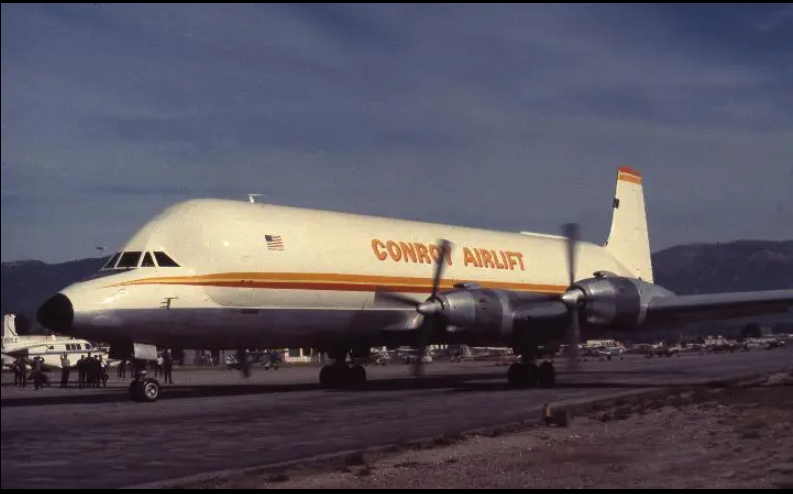
First Flight Santa Barbara Photo: Courtesy of Angelee Conroy
A few years ago I was saddened to learn of the planned destruction of another milestone in commercial aviation. Anytime an aircraft of significant importance is broken up, even if there was a fleet of them and a few others still exist it is a loss to aviation history. In the case when a “one-of” aircraft is destroyed, it is a historical tragedy.
Since the CL-44 Guppy left Tennessee in September 2002 and shortly thereafter was grounded in England, it’s fate has been in jeopardy. In the last twenty-two years, the last “Guppy” class aircraft designed by Jack Conroy has been slated for the chopping block. The only CL-44 guppy built 9G-LCA (N447T) has been parked at Bournemouth airport England for over twenty years. It was sometimes maintained but has been slowly deteriorating. Sometime ago, a longtime friend in London emailed and said the CL-44 was scheduled to be broken up on 11 February 2021. Years have passed since then and somehow it has received a reprieve.
The story of the Conroy CL-44 Guppy is the first chapter in my next book, volume II of Ultra-Large Aircraft 1970-2030. The CL-44 should have been included in the first volume to round out Conroy guppy production, but space and deadlines changed the plan. This brief background tells the story.
Jack Conroy built the first B-377 Pregnant Guppy in 1962 by cobbling together multiple fuselage sections of retired Boeing Stratocruisers and grafting a 19-foot upper fuselage on top of the existing airframe. The “Frankenplane” flying contraption was constructed outside as if it were a backyard project. Although clumsy looking and underpowered, it saved the day for NASA by transporting rocket boosters and outsize hardware from the American west coast to Huntsville and the cape in hours instead of weeks. Marshall Space Flight Center director Wernher von Braun was so impressed that plans began immediately for a second larger version. The B-377 Super Guppy with a 25-foot diameter fuselage was even bigger, first flying in 1965.
Both the Pregnant and Super Guppy were built for exclusive NASA and DOD work. So many shortcuts were taken in construction to get them finished they had to be declared “public aircraft.” This designation is how military aircraft are certified which prevents them from ever being used as commercial transports without serious upgrades. Jack Conroy had envisioned a commercial version guppy from the outset. His next project was the B-377 Mini Guppy which first flew in 1967. It had a much longer 132-foot long fuselage with 91.5-foot cargo hold ahead of the fuselage break. The smaller diameter fuselage is 15.5-foot high and was the only B-377 guppy with a hinged swing tail. The Mini was a commercial success almost immediately and a money maker for it’s entire service career.
Shortly after the Mini Guppy was completed, Jack Conroy had a dust up with the management of Unexcelled Corporation, which was the parent of Aero Spacelines. Conroy departed and went across the field at Santa Barbara Airport and founded Conroy Aircraft Corporation. Aero Spacelines went on to produce a turbine powered mini version designated the MGT-101 Mini Guppy. Two more second design Super Guppy SGT-201s were also produced in Santa Barbara and two in France for Airbus. The last one built is still in service with NASA as of 2024.
Conroy had multiple aircraft modification projects in progress at his new company in 1970, including the Turbo-Three and STOLifter. However, his primary objective was a new type of expanded fuselage Mini Guppy with visions of an advanced Super Guppy based on the Canadair CL-44. This airframe was selected for multiple reasons. As a long-range turbine powered swing-tail cargo aircraft with a 136-foot long fuselage, it was the perfect candidate for conversion.
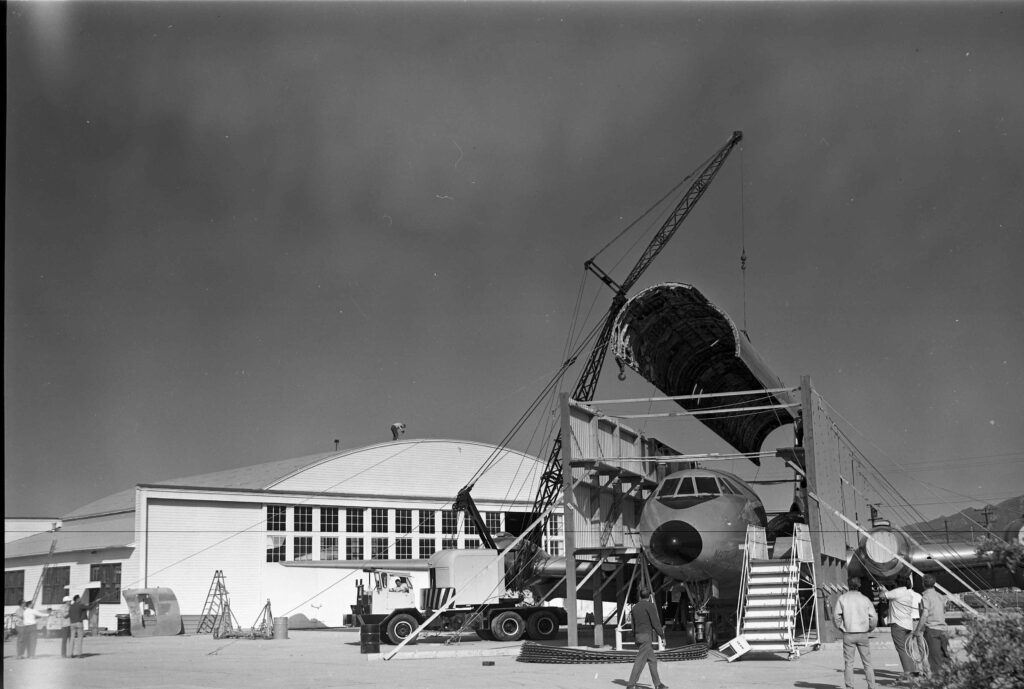
Without suitable facilities at Santa Barbara, Jack Conroy was once again faced with converting an airframe outside. This time however, as the airframe was dismantled and cut longitudinally at floor level a temporary hangar was built over it. Everything about the CL-44 was perfect for conversion. It would not need to be stretched or require sections from other aircraft. The amount of engineering and fabrication was considerably less than the previous B-377 conversions had been.
Conroy acquired several redundant CL-44s from Flying Tiger Airlines in a rather curious but not defined deal with CEO Robert Prescott. While several CL-44s were supporting oil well operations in Alaska for Mobil Oil, Conroy began converting N447T. The new Conroy model 103 was the first with plans to convert the others when they returned from Alaska. The expanded CL-44 flew from Santa Barbara on 28 November 1969. The flight was commanded by Captain Jim Seymour with Lockheed test pilot Herman “Fish” Salmon as co-pilot and Jeff Seidemen as flight engineer. Seymour had logged more than 5,000 hours on the CL-44. The modified Conroy CL-44 had a new volumetric fuselage which was more oval at eleven feet high and thirteen feet wide at mid height. Throughout the spring of 1970, it was flown in a test and certification program.
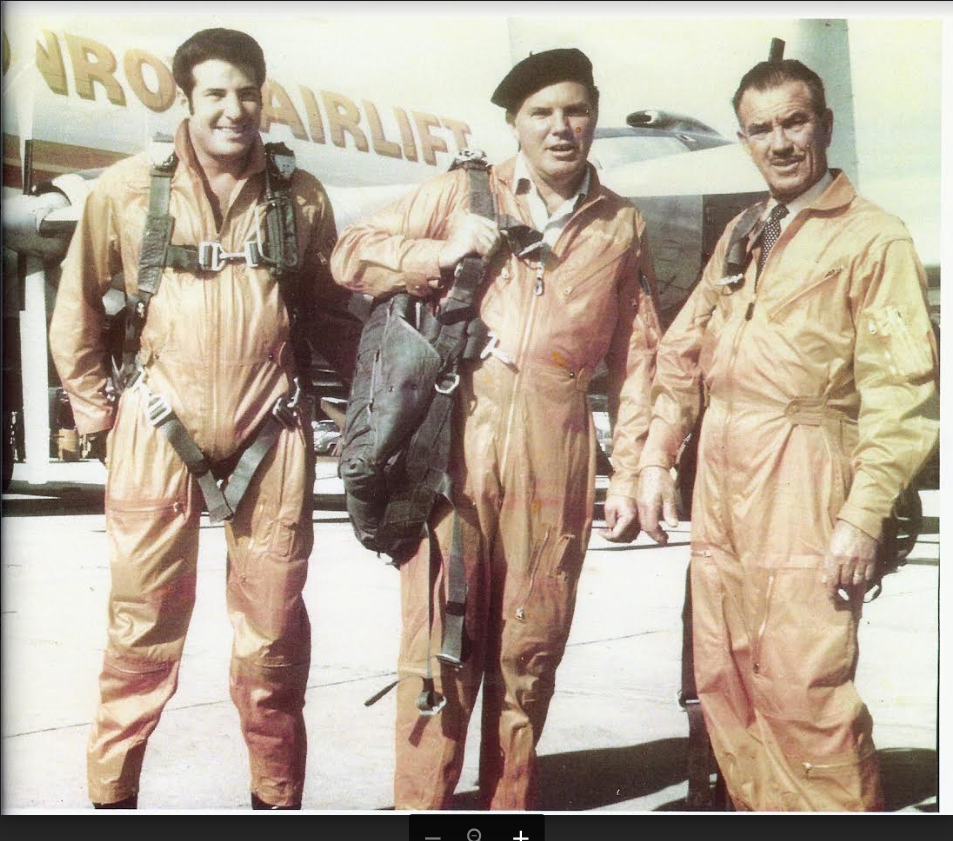
Photo: Courtesy of Jim Seymour II
On 08 April 1970 during certification testing the modified CL-44 was flown to 25,000 feet with a FAA pilot in command. The pilot nosed the aircraft over for a dive test with too much power on. The aircraft accelerated downward past Mach .73 at which time they lost control. The aircraft began violently shaking almost coming apart. It began sheading panels and parts. The tail was damaged as the co-pilot who was a seasoned CL-44 captain gained control and leveled off at 15,000 feet. The aircraft suffered severe damage, but the crew was able to land safely at Edwards Air Force Base. The next day, Conroy and his team were on a conference call to Canadair about the incident. The Canadair team was shocked. One of the engineers stated, “You flew it to .75 Mach and you are still alive.” The aircraft was repaired over the next few months; however, the left horizontal stabilizer had been distorted and always had a downward droop the entire operational life.”
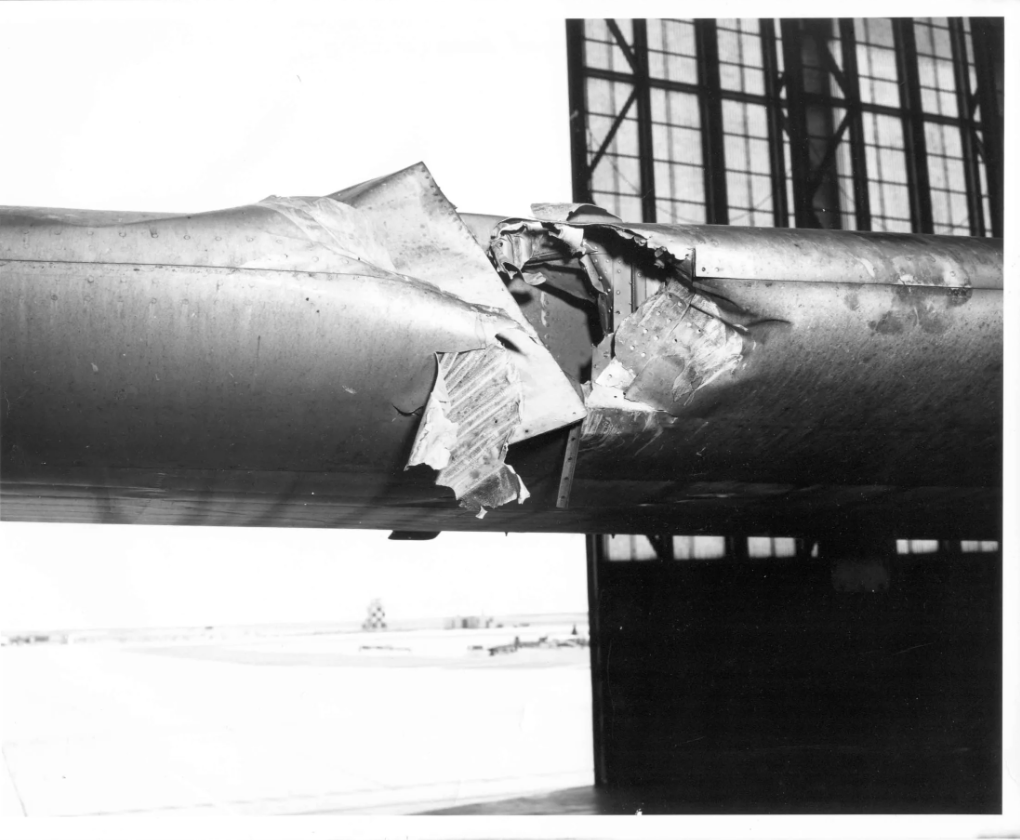
Shortly after it was repaired and certified, Conroy forfeited the CL-44 Guppy because of financial difficulties. Robert Prescott, who had not been fully paid for the aircraft, negotiated a lease, sale agreement with T.D. Mike Keegan of Transmeridian Air Cargo and British Air Ferries (BAF). Keegan already operated standard cargo CL-44s and ATL-98 Carvairs under BAF. The (Conroy 103) CL-44 Guppy was renamed “Skymonster” and was an immediate success. Mike Keegan’s brother Kevin stated years later that the guppy grossed more profit in cargo transport than all the other CL-44s in his fleet combined. This was the last guppy type conversion produced by Jack Conroy. He had conducted engineering studies and made major plans for an even larger diameter CL-44 named the Colossus with a 25-foot plus diameter fuselage and 152-foot length with six engines. Sadly, it was never produced.
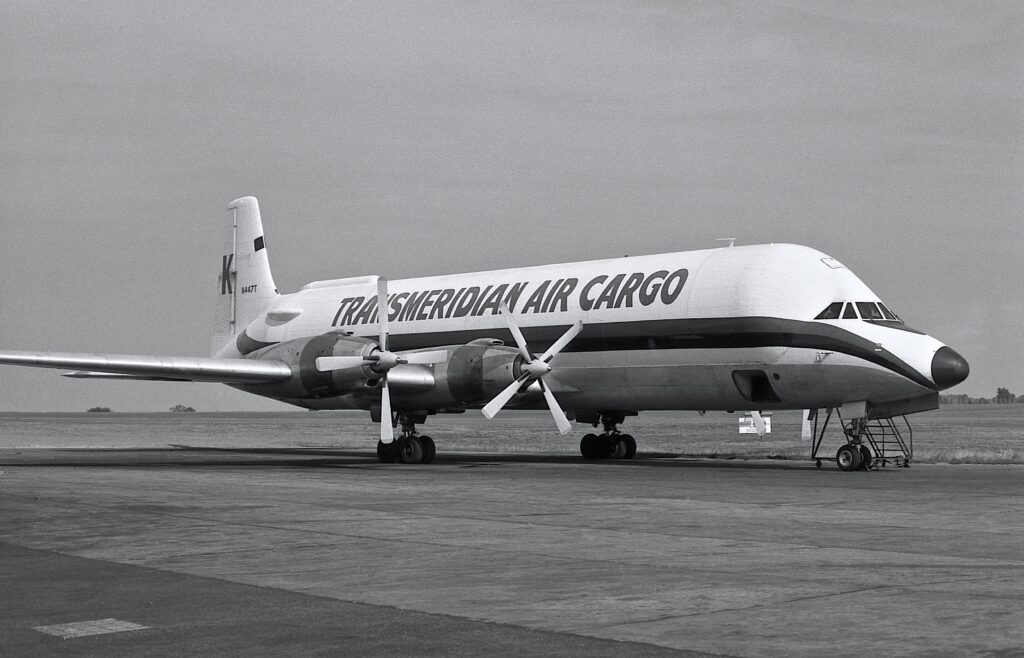
Transmeridian operated the CL-44 until December 1978 when it was sold to Heavyweight International. It was owned or leased by multiple carriers and individuals over the next 25 years including British Cargo Airlines, Aviation Leasing Group (ILG/LCA), Heavylift Cargo Airlines, Buffalo Airways, Azerbaijan Airlines, BAKU Express, First International Airlines (FIA), and Johnson Air. Many of the operators were subcompanies of ALG/ILG/LCA, which was controlled by Farhad Azima. The aircraft was identified with corrosion problems in the center-wing in the 1990s but continued in cargo service. It was eventually grounded at Smyrna, Tennessee. A onetime ferry permit was issued to fly it to Teeside Airport in England in 2002. It carried the Ghana registration of 9G-LCA.
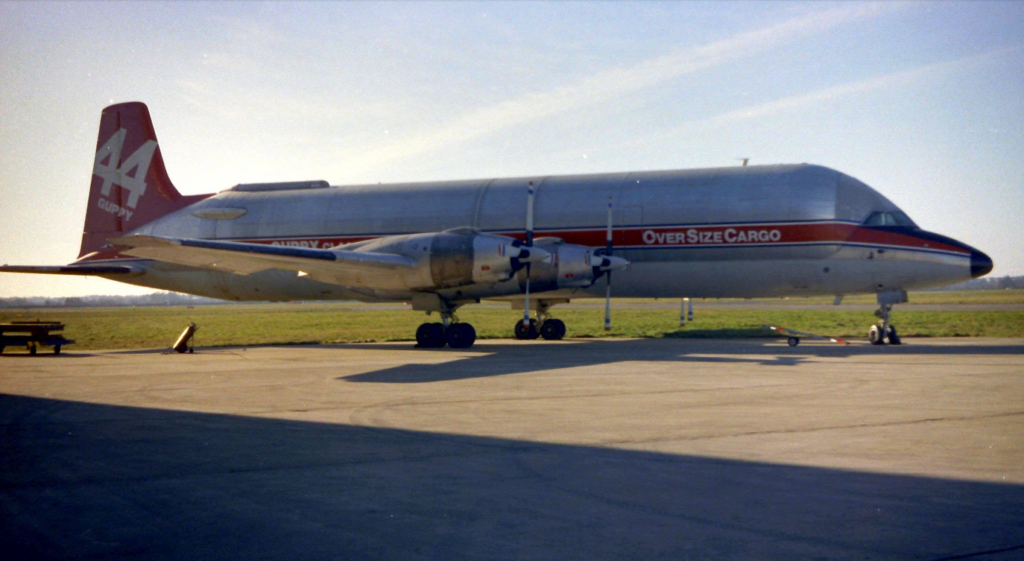
When it arrived Teeside Airport UK in 2002, the wing-root and center-wing corrosion issues had not been addressed. British authorities would not allow it to fly until repaired, which was thought to have been impossible because of lack of manufacturer support. There were no spares available, and Canadair jigs had long ago been destroyed. Permission was acquired for a one-flight ferry to a facility where repairs could be made. It was subsequently flown to Bournemouth for the purpose of getting it airworthy to acquire a certificate of airworthiness.
*(The following was related to us by Stephen “Steve” James in 2024)
Aviation Leasing Group (ALG) owned the aircraft at that time it arrived at Bournemouth. Director of Quality Control, Maintenance for ALG, Steve James, was tasked with getting the CL-44 airworthy for Johnson Air which was a cargo carrier set up by ALG. The CAA had placed a grounding order on the “Skymonster” until the aircraft records were in order verifying all remedial maintenance had been performed. The aircraft required a ‘C’ check and was known to have corrosion on the rear spar and multiple fuel leaks.
The CL-44 was towed into a hangar at Bournemouth Aviation Services Ltd. (BASCO) for the work to be carried out. After months of work, it was reported the repairs had been completed and records were to the satisfaction of the CAA. The aircraft was still on the 9G register of Ghana and received a Certificate of Airworthiness from the Ghana Civilian Aviation Authority. On ‘Good Friday’18 April 2003 a test flight was conducted out of Bournemouth. During the flight the No 1 engine was shut down with a fuel line problem. After landing the post flight inspection found the right outboard landing gear door bracket broken. Further maintenance was required. Steve James sourced a replacement gear door bracket, but nothing was done. After all the expense and maintenance work to get it airworthy it remained parked. For unknown reasons ALG lost interest and did not want to spend a few thousand more dollars to complete the work to put the aircraft back in service.
The aircraft remained grounded and ownership was reported to pass through multiple individuals. Eventually Geoff Leach contacted Steve James. He inquired as to the disposition of the aircraft and said that he had heard that James had gotten the aircraft airworthy. Leach stated he had copies of all the documentation.*
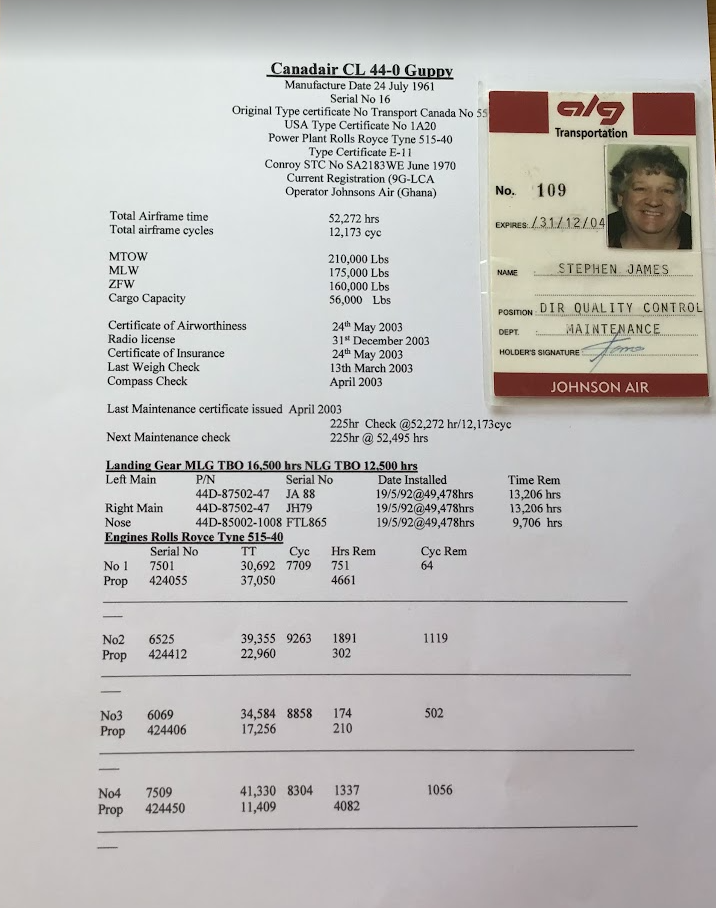
It was separately reported that it had been sold to Geoff Leach in 2003. Leach became involved in a shadowy situation with his son regarding ownership. Attempts were made to get final maintenance items signed off by personnel reported as unqualified. Eventually the engines were removed and shipped to Australia and stored. The next reported owner was David Berry, who registered it in the Philippines for an upstart cargo service in 2006. The last owner, in 2016, was an American named Wayne Harland Jordan. All the while the “Skymonster” remained at Bournemouth. The ownership passed between multiple individuals and companies, some with rather questionable intentions and credentials. After years of speculation and an uncertain fate, the end was scheduled for 11 February 2021 when dismantling was planned at Bournemouth and it was moved to a scrapping area.
When it arrived at Bournemouth in 2002, severe wing root and spar corrosion issues were the reason British authorities would not allow it to fly until repaired. Steve James account tells us the issues were resolved. However, Certificate of Airworthiness was issued by Ghana which may have influenced ALG’s decision to not expended any more funds to complete the issues found on the test flight.
The “Conroy 103 or Skymonstser” CL-44 is a “one-of-one” aircraft. In the opinion of many, it should have been placed in a museum or allowed to stand in public view for all to marvel and enjoy. This was the second time in only two months a milestone aircraft has been planned for scrapping. On 20 December 2020, the SGT-201 Super Guppy F-BTGV was broken up at Bruntingthorpe Airfield, England. It was the first SGT-201 (N211AS) originally built at Santa Barbara as a demonstration model after Conroy’s departure from Aero Spacelines. Airbus acquired it to transport A300 aircraft components between factories around Europe. Three more SGT-201s were built for Airbus and served well until replaced by the A300-600ST Beluga and now the A330-743L Beluga XL.
We are fortunate to have aircraft museums to preserve some famous and unique aircraft. Sadly, we now live in a throwaway world where little effort is made to preserve these historical flying giants. It is true they are large and require considerable space for display. However, monuments and examples of the past are no longer appreciated or respected. Milestones in aviation history have lost importance in recent years. In all fairness, this is not of late. There have been incidents in times past when significant “one-of” or low production aviation design have been destroyed with much regret after the fact.
In 1953, Northrop was ordered by the U.S. Government to destroy all YB-49 Flying Wing airframes in production. Not one example was preserved. The Wright-Patterson aircraft museum even destroyed the first hand built YC-124 which had been converted from a Douglas C-74. The museum allowed it to be used for fire department practice. Incidentally, no Douglas C-74s were preserved. We only have photos and short archival footage to remember and appreciate these unique limited production aircraft.
Whether it is for economic reasons, politics, or the short-sightedness of colossal ignorance and blazing stupidity, these milestones in aviation development are lost forever. They pass into the recesses of time and are forgotten in a generation, a shame when their significance in aircraft development is difficult to appreciate in just photos and drawings.
Nothing can take the place of seeing one of these flying giants. Anyone who visits the Pima Air Museum at Tucson, Arizona or Musee Aeroscopia at Toulouse-Blagnac, France understands when they see the original B-377 Super Guppy or SGT-201 on display. Wherever the NASA Super Guppy, Boeing 747LCF or Airbus Beluga land there are always gawking spectators peeking through the fence with cameras trying to get a glimpse. But, society in general no longer seems to care about history. The CL-44 “Skymonster,” a very special aircraft, has an uncertain fate with moving appointments with the scrap-man. I wonder if anyone would show concern if plans were made to scrap the “Enterprise, Discovery, Atlantis or Endeavour space shuttles”? After all they are cargo aircraft. Do children even learn about aviation achievements in school anymore?
There are those who claim the CL-44 is still airworthy however, it is more of an intact museum piece than a flyable airframe. To lift the grounding order the CAA would require proof of sufficient remedial certification work being completed to make it airworthy. The cost of repairs would be millions of dollars. Corrosion in the wing roots exist and is believed to be extremely severe. Patching and “doubler plates” would not be sufficient. The wing spar would need replacement which would require support from Bombardier (Canadair successor). The four Rolls-Royce Tyne engines would require overhaul at a minimum cost of $800,000 USD. The type certificate for the engines has long been cancelled and the props are unsupported with no overhaul facility certified for service. Finally there is no longer a type rated crew to fly it.
As of 12 February 2024, the CL-44 Guppy “Skymonster” is still intact. It is currently parked on a hardstand separate from other aircraft. (Header Photo Courtesy: Nigel Poll 02 Feb 24) Unfortunately she languishes at Bournemouth with an uncertain fate.
The engines were previously advertised for sale in April 2023, however they appear to still be mounted on the aircraft since the cowlings are in place. The prop has been removed from #3 engine. The airframe appears intact as noted from a distance. However, it has been allowed to deteriorate with considerable mold buildup on the entire aircraft. Some of the old crew members who have long since retired have expressed concern of her fate. We are all sadden with the decision made in December 2024 which sealed the fate of this landmark aircraft. The CL-44 Skymonster was broken up with some parts being acquired by a museum where they will be placed on public display. Why it could not go to a museum intact is still not clear. An update and complete accounting is forthcoming.
There was a time when an airplane flew over and people would stop and look up. I still do. Will that time ever return?
Update 18 August 2024:
We are saddened to learn that longtime advocate for the CL-44 Guppy Colin Biddlecombe passed away on 05 June 2024. He has fought tirelessly with the Bournemouth Airport authorities to preserve the CL-44 Guppy that has been parked there for years. Unknown to us, Mr. Biddlecombe owned shares in the Guppy and had power of attorney from Geoff Leach to act on his behalf to preserve it. He has expended thousands from personal funds engaging a solicitor and attempting to put together a sale to a group or museum where it would be preserved. He was negotiating with a museum in Germany at the time of his passing.
Mrs. Biddlecombe tells us the aircraft is now under the control of Mr. Tim Etches of Bournemouth Airport authority who is a longtime advocate for it to be scrapped. Sale of the aircraft to the museum in Germany has been abandoned and it is currently planned to be broken up. We have been told, although not verified, that the windscreen has been broken out as an effort to declare it derelict so the process can move forward to scrap it.
Update: October 2024: Mark Joseph has reported, “It is still in on piece.”
Update: 02 December 2024:
We have all feared the day would come when the ‘Skymonster’ would become a lost relic of aviation history. I was saddened today when I received the following from Gary Smith. “According to the Bournemouth Aviation Museum, outside the airport, the plane is officially being broken up.” Other sources are saying the breakup of the aircraft will begin the week of December 9th.
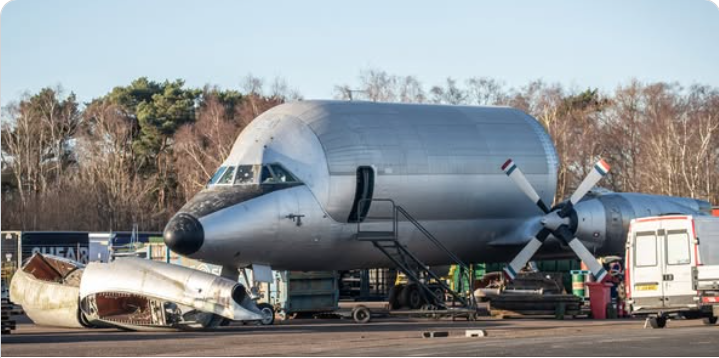
A legendary cargo liner reduced to memories. Photo: Courtesy of George McDowell
Update: 06 December 2024: We were informed that during the end of the week of 02 December 2024, the dorsal fin, stabilizers, and outer wings were removed and the airframe was towed to the apron outside European’s hangers where dismantling is scheduled to begin. We were recently informed that the cockpit was removed but the museum which was scheduled to take it has now cancelled. Currently it is scheduled to be taken to the Welsh Aviation Museum at St. Athan.
Update: 27 March 2025: Tony York reported, “the cockpit section of the CL-44 Guppy left Bournemouth airport on the back of a lorry heading north up the A338.” Destination unknown.
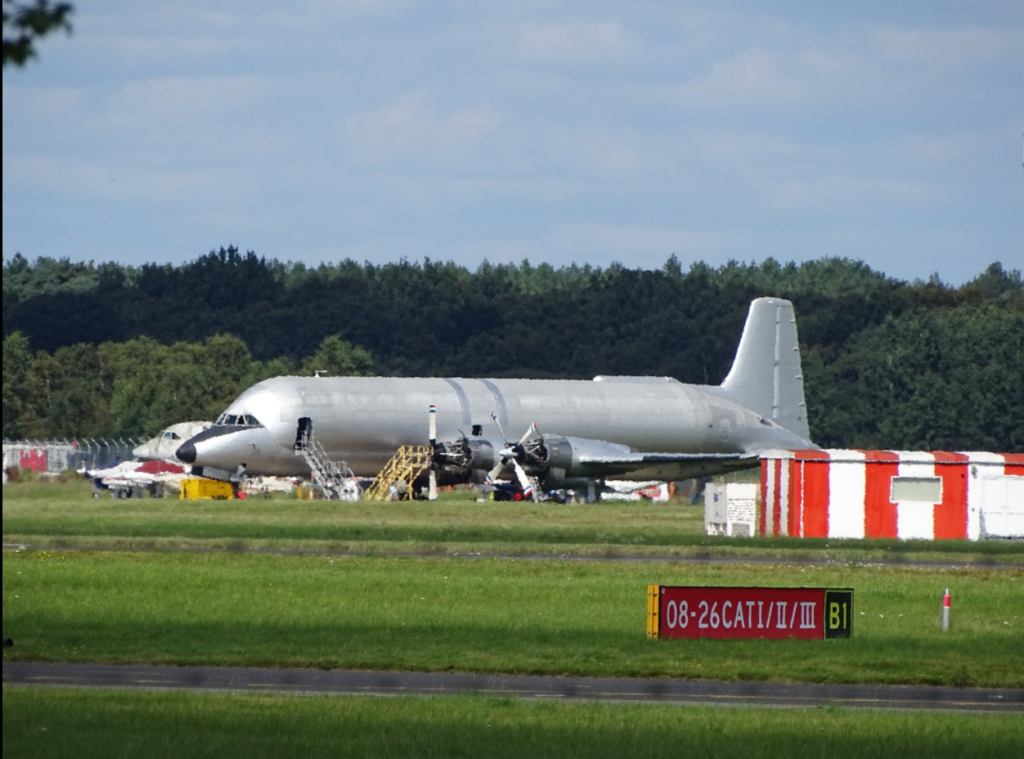
Photo: Nigel Poll 02 Feb 24
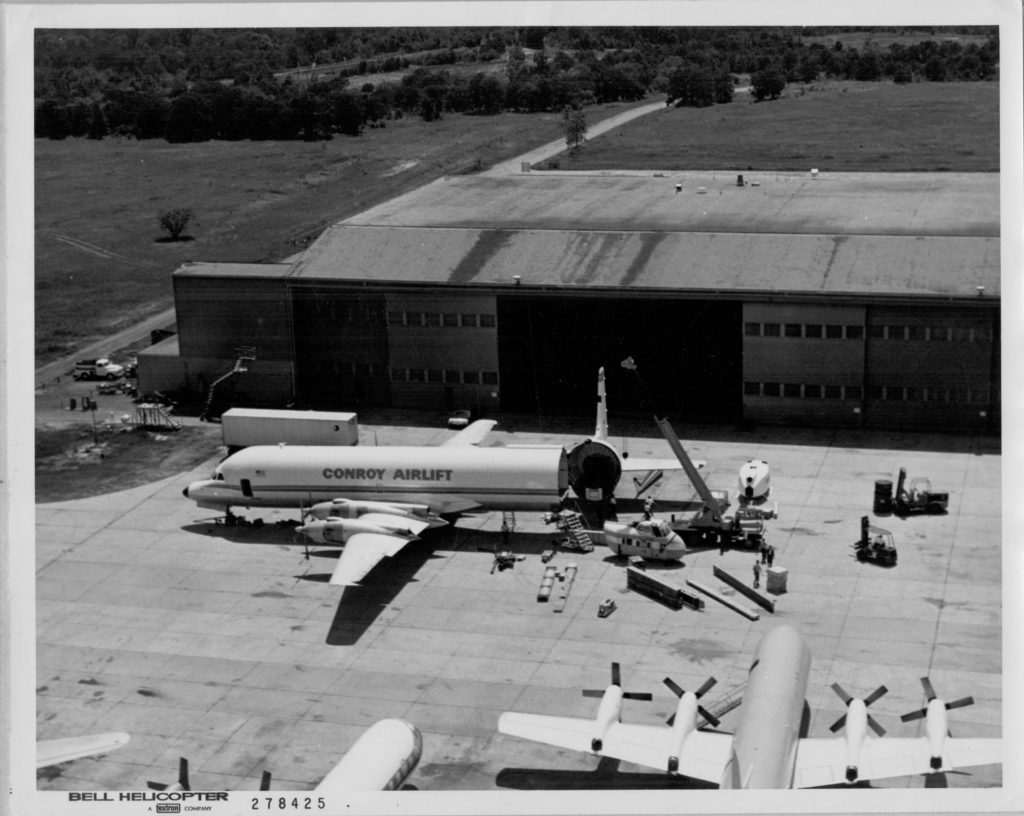
Thanks to CL-44 crew members Capt. Jose Munoz, Capt. Rory Keegan, Julian Hockbridge, F/E Mick Patrick and Maintenance Tech LeRoy Fry and Steve James, and many others for their comments.
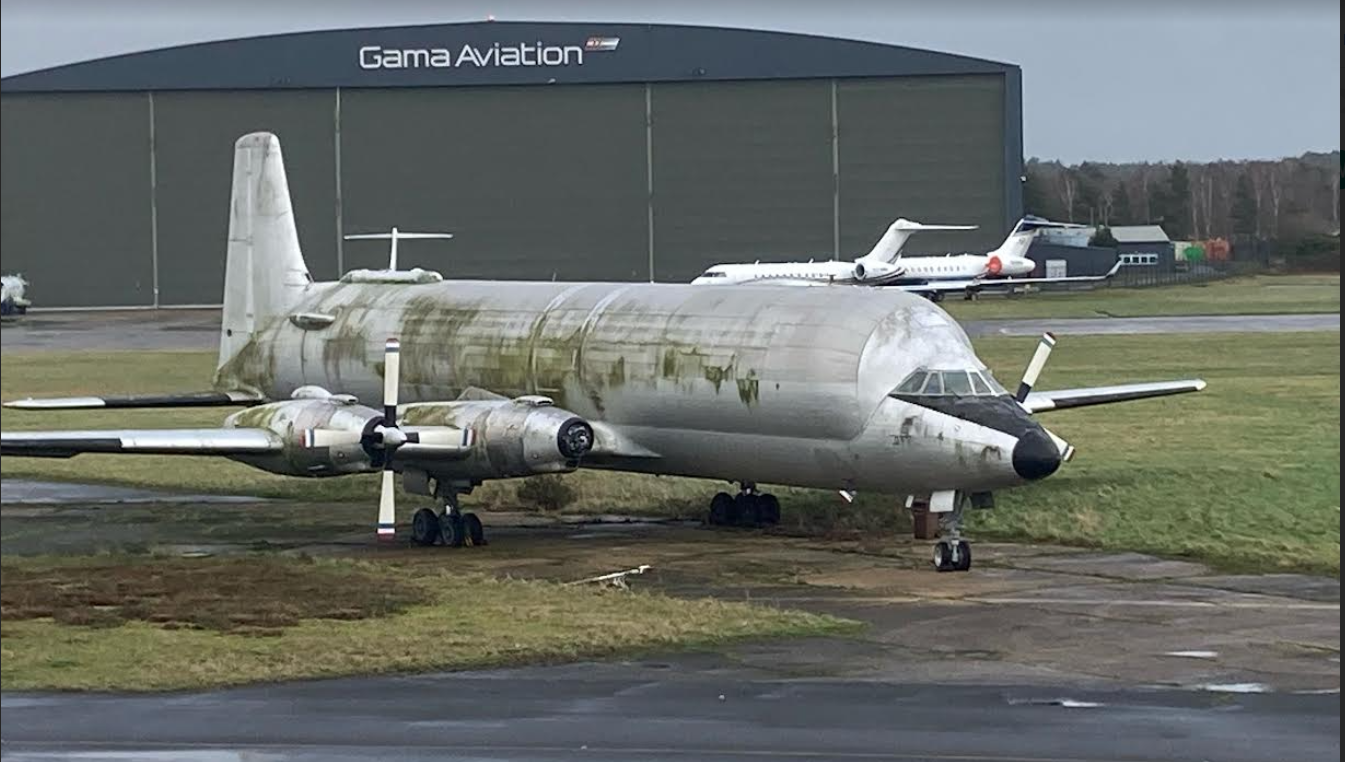
Pat, In the left photo, the helo farthest from the camera may be a Bell aircraft, but the one in the foreground is a Sikorsky and probably an S-58. Les
Hi,
I was at Bournemouth Airport today and I would like to confirm the Guppy has not been broken up!! I was told by another source it had been scrapped, but it was still parked at BOH today.
Not sure why it was confirmed of its scrapping, but still parked in the same place at BOH.
Hi William!, sorry news indeed that the convoy is no more!, what a shame even duxford would not take the old lady I grew up living at standard and saw it many times I loved the cl-44 sound of those tunes a great sound!, I know the chap mr porter ex loadmaster tried in vain to save this great prop cargo carrier!, the airbritan book on the cl-44 was very informative thank god I have loads of pics when serviceable a lovely model and still make kits of them
Hello mr.Dean,
Could you please alter the title of this article. The aircraft is sitill in airworthy condition and FAR from being scrapped. Therfor its tedious to my opinion to write as if it has already happend. She’s still complete. I will keep you posted on any developments. Sincerely, Peter van Leeuwen CL44.COM
Thanks to everyone for your comments and updates. The CL-44 essay has been updated to reflect the aircraft has once again received a reprieve from the scrap man.
Wow…. the suspense is almost too hard to take. Fingers crossed as always for the Sky monster.
I was a flight mechanic on this aircraft for over a year back in 1995 when it was operated by Buffalo Airways. I transitioned to it from the DC-8 and the B-707 because no one wanted to work or fly on it. Being only 24 years old, I jumped at the chance. We only had two sets of flight crews and four dedicated mechanics to the aircraft so we were a close group of guys. I learned very quickly how realizable it was compared to the DC-8 and the B-707. Our service ceiling was only 20,000’ because the the pressurization for that much area was difficult using the original pressurization system for the Smaller original, CL-44 Skymaster fuselage. My only complaint was how loud and cold it was within the currier and cargo sections of the Guppy. Other than that, I absolutely loved the aircraft, and my brothers who operated and maintained it. I took pride in showing it off wherever we landed. Funny I seen pictures of it two or three owners later and still noticed some of my touch ups were still being maintained. We came back to home base for a couple of weeks and I decided to paint two black stripes on the horizontal stab to hide the exhaust streaks left by the two inboard engines. And the fiberglass crown above the cockpit, where an emergency exit hatch is located, had been paint peeled for years. I reglassed it and repainted to a glossy dark gray that I noticed still held up well over the years. Obviously, someone had kept up with my contributions to the ships esthetics, which made me proud.
I traveled all over the world hauling all kinds of goods on the Guppy. Secret Full size clay model cars( with curriers included to make sure we didn’t take pictures), oil drilling equipment to St. Croissant, empty one gallon jugs for water to st. Thomas after Hurricane Andrew, military vehicles, an entire engine change equipment for a B-767 to Bermuda, Roll Royce aircraft Engine parts to England, just to name a few. But our “meat and potato” run was hauling B-777 Reversers from Boeing field in Wichita, KS to Boeing in Seattle. These were just a few of many trips that I made on This one of a kind, aircraft. I was also responsible as a loadmaster of Guppy. We I was done unloading and loading the cargo, I would have opportunity to work on the plane which means when I was done with those duties, it was usually time to take off again for the next destination. Though I am still an aircraft mechanic today, I still like to check up on one of the great experiences of my life. Hope she gets in the air soon. I wouldn’t mind working on the ol girl again.
I crossed the Atlantic a couple of times on the Skymonster. We operated it for years at Transmerdian, loved the CL44, a great plane.
Hi there was just wondering is the aircraft ever going to fly again or is it going to be scrapped
Interesting! I also found this page after seeing the engines for sale.
I wish I lived near Bournemouth to go and see this. Such a shame
After living in poole most of my life and going past Hurn all the time I always wondered why it wad just sat there. At one point I was told by the aviation museum opposite Hurn that it was going to be going to Germany to be in a museum(if memory serves me right) but that was a fair few years ago now. I just came across this page after seeing a Facebook marketplace listing for 4 cl44 engines and I would guess these would be from the guppy so possibly it’s finally been broken up unfortunately 🙁
ROLLS ROYCE TYNE ENGINES X 4
Here is the advert for the engines:
About to be removed from the world famous Guppy CL44
Running order
There are 4 enh
Gines at £1000 each
If you have any questions please ask
THANK YOU FOR LOOKING. See less
Nathan, Do you have contact details for the owner/seller, please?
Hey Y’all. Aircraft is still there on NW side of what used to be runway 17/35 in Google Maps aerial photo dated 2023, no month given. And it has engine cowlings and propellors in place in the image which may or may not be from before Nathan’s March 29 post.
I passed through Bournemouth Airport today, 18th Sept 2023 and the CL-44 was still there, intact with engine cowlings and props in place. I assume engines were also in situ. It even looked clean and shiny, though I was at the arrivals terminal on the other side of the airfield to the Guppy, so a fair way away, even with binoculars
Hi all. I work in an office overlooking the CL-44 and it’s still in one piece (just about) but rather the worse for wear. Its still where Google Maps’ satellite view shows it (50°47’07.8″N 1°50’36.9″W). I’ll email a couple of photos to William that he can publish here is he wishes.
I am glad the Guppy is still in one piece.
I hope someday in the near future this marvel could be placed in a public place as a static display. Instead of destroying it along with it superb history .
Captain Jose A munoz
Who would be the contact person for an offer to purchase the Guppy?
I flew many hours in the CL44, with the Famous Captain Jose Munoz. Captain Munoz is an exceptional Pilot and 100% professional Airman in all respects.
I had the pleasure of working on this aircraft in the seventies with TMAC I was an avionics engineer.
Still in one piece October 2024. Caught a glimpse as I drove by and checked it out. Interesting story. Would be criminal to break her up.
According to the Bournemouth Aviation Museum, outside the airport, the plan is officially being broken up 🙁
Sadly, over the last few days, the fin, stabs and wings, (down as far as the outboard engines), have been removed. The aircraft has now been towed to the apron outside European’s hangers, for final dismantling.
Wayne Jordan Harlan [N447FT]
Type: Canadair CL-44
Airport: , United Kingdom, Bournemouth (BOH) ()
Comment: Das CL-44-0 Conroy Skymonster „Guppy“ hat seine langjährige Ruhestätte zum Vorfeld der European Aviation verlassen und ist jetzt bereit für den Straßentransport zum Welsh Aviation Museum in St. Athan. / The CL-44-0 Conroy Skymonster “Guppy” has left its longtime resting place to the European Aviation ramp ready for road-transport to The Welsh Aviation Museum at St Athan.
https://www.skyliner-aviation.de/showphotos.main?LC=nav2
https://www.bournemouthecho.co.uk/news/24774309.skymonster-plane-grounded-airport-saved-sort/
I have managed to aquire vast amounts of paperwork regarding this aircraft and it turns out the museum at St- Athan do not want it. I contacted the owners who have told me to dump it which I will not do (yet) so if anyone is interested in it please get in touch (the location of it is in Bournemouth)
On Thursday 27th March 2025 the cockpit section of the CL-44 Guppy left Bournemouth airport on the back of a lorry heading north up the A338. Hopefully to a good home. Does anyone know where?
I was called to help clear a workshop close to Bournemouth airport.
In amongst the stuff for removal is about 1000 blueprints of parts for the Conroy Skymonster CL-44 GUPPY.
I could not bring myself to allow these valuable documents to end there days in land fill.
J will try to contact aviation museums to see if I can donate them for future generations to learn from.